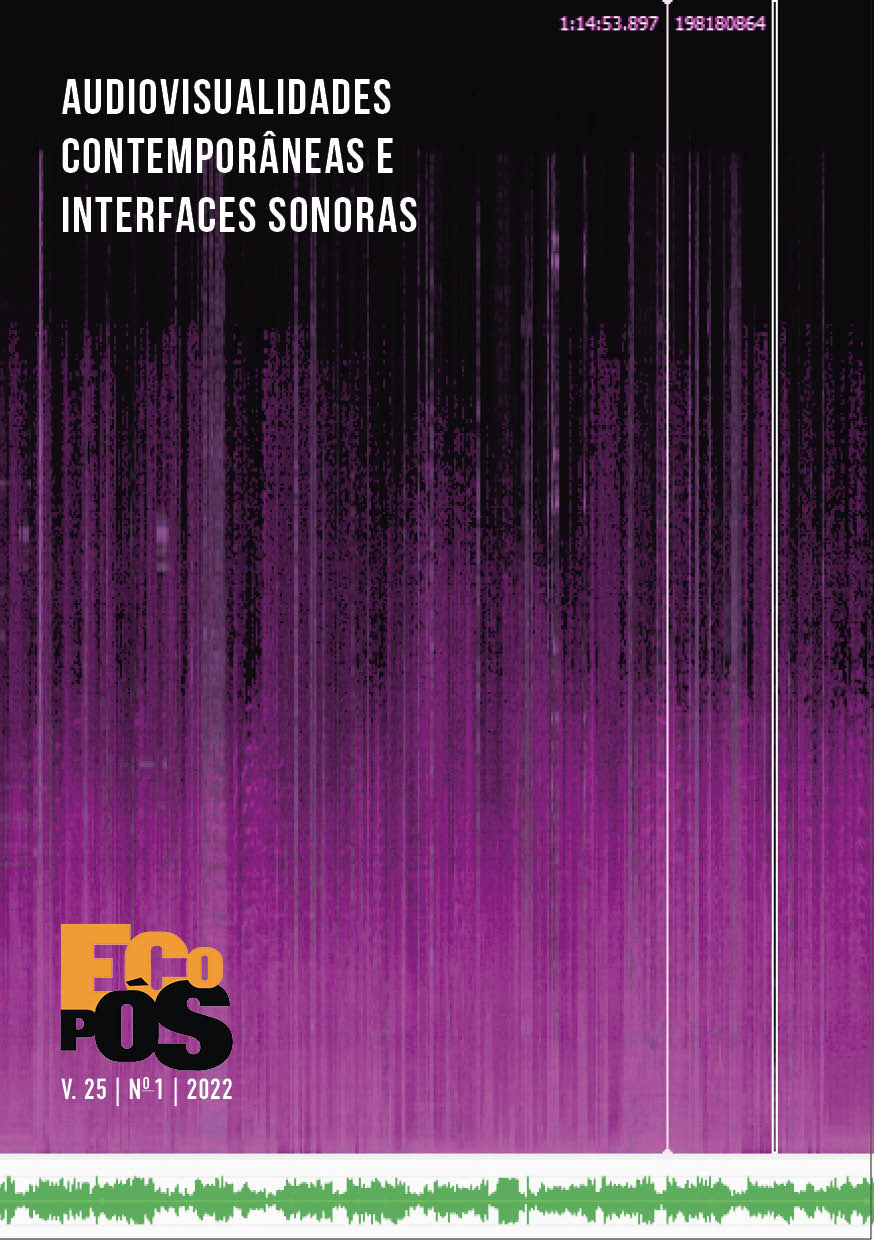Fantasmagoria Maquínica
Mídia e memória no design sonoro dos jogos digitais
DOI:
https://doi.org/10.29146/ecops.v25i1.27819Keywords:
Media ecology, Audiovisual memory, Digital games, Sound Design, AestheticsAbstract
Throughout the historical development of new technologies, operational noises and unintentional sounds from each medium were absorbed as part of aesthetic repertoires. As electricity became a daily conductor of energy, the sound of electrical failures began to coexist with sounds of creaks and collisions of the mechanic milieu. In contemporary sound design, electric clacks and rumbling motors coexist with new noises provided by digital techniques and aesthetics. By observing the case of digital games, we propose to think such sonic phantasmagoria as a creative process that stems from the cultural memory of media, opposing the current understanding of audiovisual memory as an inventory to be filled.
Downloads
References
K GAMES. Spec ops: the line. 2012 [videogame].
AUGOYARD, J. ; TORGUE, H.Sonic experience: a guide to everyday sounds. Montreal: McGill-Queen’s University Press, 2006.
BAYLESS, R.; Rogo, S. Phone calls from the dead.New York: Berkley, 1979.
BERGSON, H. A evolução criadora. São Paulo: Martins Fontes, 2005.
BRAGUINSKI, N. The resolution of sound: understanding retro game audio beyond the ‘8-bit’ horizon. NECSUS European Journal of Media Studies, v. 7, n. 1, p. 105–121, 2018.
CANNAN, C.; LANDONE, C.; SANDLER, M. Sonic Visualiser: an open source application for viewing, analyzing and annotating music audio files. In: Proceedings of the ACM Multimedia 2010 International Conference. ACM International, p. 1467-1468, 2010.
CHION, M. A audiovisão: som e imagem no cinema. Lisboa: Texto&Grafia, 2011.
COLLINS, K. Game sound: an introduction to the history, theory and practice of video game music and sound design. Cambridge: MIT Press, 2013.
COOK, N.; LEECH-WILKINSON, D. A musicologist’s guide to sonic visualizer. Londres: Center for the History and Analysis of Recorded Music, 2009. Disponível em: http://www.charm.rhul.ac.uk/analysing/p9_1.html.
DAVIS, E. Techgnosis: myth, magic and mysticism in the age of information. New York: Harmony Books, 1998.
DELEUZE, G. A ilhadeserta. São Paulo: Iluminuras, 2009.
DEVINE, K. Imperfect sound forever: loudness wars, listening formations and the history of sound reproduction. Popular Music,v. 32, n. 2, p. 159-176, 2013.
DUBOIS, P. Cinema, video, Godard. São Paulo: Cosac Naify.
ELECTRONIC ARTS (2008). Mirror’s Edge [videogame].
ELECTRONIC ARTS.(2016). Battlefield 1 [videogame].
FLUSSER, V. Comunicologia. São Paulo: Martins Fontes, 2015.
FLUSSER, V.O mundo codificado. São Paulo: CosacNaify, 2007.
FLUSSER, V. On memory (electronic or otherwise). Leonardo, v. 23, n. 4, p. 397-399, 1990.
FUCHS, M. Phantasmal spaces: archetypical venues in computer games. New York: Bloomsbury, 2019.
KELLY, C. Cracked media. Cambridge: MIT Press, 2009.
KITTLER, F. Optical media: Berlin lectures 1999.Londres: Polity, 2010.
KOHATA, S., SHINDO, M. The spatial acoustics of Nier: Automata. Audiokinetic Blog. Montreal, 4 dez. 2018. https://blog.audiokinetic.com/the-spatial-acoustics-of-nierautomata-and-how-we-used-wwise-to-support-various-forms-of-gameplay-part-1/.
KONAMI (2014). Metal Gear Solid 5: Ground Zeroes [videogame].
KRAPP, P. Noise channels: glitch and error in digital culture. Minneapolis: Minnesota University Press, 2011.
KRAPP, P. Seminário Déjà vu: aberrações da memória cultural. Notas. Universidade do Vale do Rio dos Sinos, 2018.
LEVIN, T. Y. “Tones from out of nowhere”: Rudolph Pfenninger and the archaeology of synthetic sound. Grey Room,v.12, p. 32–79, 2003.
LUERSEN, E. H.;MASCHKE, G. M. Erro e ruídona tecnocultura contemporânea - Entrevista com Peter Krapp. Galaxia, n. 39(set/dez), p.15-22, 2018.
LUERSEN, E. H. Ressonância tecnocultural: rastros da ambiência contemporânea nas sonoridades dos jogos digitais. Tese (Doutorado em Ciências da Comunicação) - Universidade do Vale do Rio dos Sinos, 2020.
MAHER, R. Audio forensics examination. IEEE Signal Processing Magazine, v. 26, n. 2, p.84-94, 2009.
MANOVICH, L. The language of new media. Cambridge: MIT Press, 2001.
MATTERN, S. Auscultação urbana: ou percebendo a ação do coração. Rua, v. 26, n. 2, p.385-411, 2020.
MOHOLY-NAGY, L. Production-Reproduction. De Stijl, v. 5, n. 7, p.98-101, 2020, 1922.
PETTMAN, D. Sonic intimacy: voice, species, technics (or, how to listen to the world). Stanford: Stanford University Press, 2017.
PHILLIPS, W. A composer’s guide to game music. Cambridge: MIT Press, 2014.
RAUDIVE, K. Breakthrough: an amazing experience in electronic communication with the dead. Buckinghamshire: Smythe, 1971.
RILKE, R. M. Sämtliche werke. Frankfurt: Insel, 1955.
SCHAFER, R. M. A afinação do mundo. São Paulo: Unesp, 1997.
SCHNEIDER, B. On hearing eyes and seeing ears: a media aesthetics of relationships between sound and image. In: Daniels, D., Naumann, S. (Eds.). Audiovisuology, a reader, Vol. 1: Compendium, Vol. 2: Essays. Köln: Verlag Walther König, p. 608-633, 2015.
SHAW, D. B. Technoculture: the key concepts. Oxford: Berg, 2008.
SMALLEY, D. Spectromorphology: explaining sound-shapes. Organised Sound, v. 2, n. 2, p. 107-126, 1997.
Square Enix (2017). Nier: Automata [videogame].
STIEGLER, B. Technics and time 3: cinematic time and the question of malaise. Stanford: Stanford University Press, 2011.
STUDIO MDHR (2017). Cuphead [videogame].
SWEET, M. Writinginteractivemusic for videogames. Indiana: Pearson, 2014.
WEISSBERG,J.Do real ao virtual.In:Parente, A. (org.). Imagem-máquina: a era das tecnologias do virtual. São Paulo: Editora 34, 1999.
Downloads
Published
How to Cite
Issue
Section
License
Copyright (c) 2022 Eduardo Harry Luersen

This work is licensed under a Creative Commons Attribution 4.0 International License.
Aos autores pertence o direito exclusivo de utilização ou reprodução.
Você tem o direito de:
- Compartilhar — copie e redistribua o material em qualquer meio ou formato.
- Adaptar — remixar, transformar e construir sobre o material para qualquer filme, mesmo comercial.
O licenciante não pode revogar esses direitos, desde que você respeite os termos da licença.
De acordo com os seguintes termos:
- Atribuição — Você deve dar o devido crédito, fornecer um link para a licença e indicar se essas alterações foram feitas. Você pode fazê-lo de qualquer maneira razoável, mas não de maneira que sugira que o licenciante endosse ou aprove seu uso.
- Sem restrições adicionais — Você não pode aplicar termos legais ou medidas de natureza tecnológica que restrinjam legalmente outros de fazer algo que a licença permite.
Aviso: A licença pode não fornecer todas as permissões necessárias para o uso pretendido. Por exemplo, outros direitos, como publicidade, privacidade ou direitos morais, podem limitar a maneira como você usa o material.











